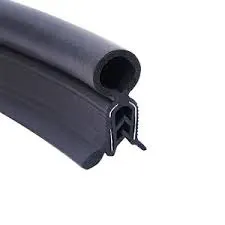High-Quality Windshield Sealing Strips for Effective Water and Air Protection
Oct . 22, 2024 07:52 Back to list
High-Quality Windshield Sealing Strips for Effective Water and Air Protection
Understanding Windshield Sealing Strips Importance, Types, and Installation
Windshield sealing strips, often referred to as windshield weatherstrips or seals, play a crucial role in the integrity of a vehicle's windshield. While these strips may seem like minor components, their function is vital for ensuring safety, comfort, and durability. This article delves into the importance of windshield sealing strips, various types available, and installation processes.
Importance of Windshield Sealing Strips
1. Water Resistance One of the primary functions of a windshield sealing strip is to prevent water from entering the vehicle. A well-sealed windshield minimizes the chances of leaks, which can lead to significant interior damage, including mold growth and electrical issues.
2. Wind and Noise Reduction Windshield sealing strips help to reduce wind noise while driving, creating a more comfortable experience for passengers. A tight seal minimizes airflow into the cabin, leading to a quieter ride.
3. Structural Integrity In the event of a collision, the windshield provides structural support to the vehicle. Properly installed sealing strips ensure that the windshield remains securely in place, which can be critical during an accident.
4. UV Protection Some sealing strips are designed to protect against ultraviolet rays. This helps in preserving the interior of the vehicle by preventing fading and damage caused by prolonged sun exposure.
5. Aesthetic Appeal Windshield sealing strips contribute to the overall appearance of the vehicle. Worn or damaged strips can be unattractive and detract from the car’s aesthetic, making regular maintenance crucial.
Types of Windshield Sealing Strips
1. Rubber Sealing Strips Rubber is one of the most commonly used materials for windshield sealing strips. It is flexible, durable, and can withstand various weather conditions. Rubber strips are often found in both OEM (original equipment manufacturer) and aftermarket applications.
2. Vinyl Sealing Strips Vinyl is another material used for windshield seals. It may not be as resilient as rubber but is generally less expensive and easier to install. Vinyl strips are typically used in less demanding environments.
3. Foam Sealing Strips Foam strips are designed to fill gaps and provide additional cushioning. They are often used for temporary fixes but can also serve well in specific applications.
windshield sealing strip product

4. Butyl Sealing Strips Butyl sealing strips feature excellent adhesive properties, making them ideal for permanent installations. They remain flexible and can create a watertight seal. However, butyl strips can be more challenging to work with due to their adhesive nature.
5. Multi-Purpose Strips Some sealing strips are designed to serve multiple functions, such as acting as both a weatherstrip and an aesthetics enhancer. These strips can come in various materials and configurations to meet diverse needs.
Installation Process
Installing a windshield sealing strip can be a straightforward process, but proper technique is crucial for ensuring effectiveness and longevity. Here’s a basic guide to installing a windshield sealing strip
1. Preparation - Gather the necessary tools, including a utility knife, adhesive, and a cleaning cloth. - Remove the old sealing strip carefully to avoid damaging the windshield or the vehicle frame.
2. Cleaning - Thoroughly clean the area where the new sealing strip will be applied. Removing any dirt, debris, or remnants of old adhesive is essential for a secure bond.
3. Measuring and Cutting - Measure the length of the windshield accurately and cut the new sealing strip accordingly. Ensure that the cut is straight and the ends align properly.
4. Application - Apply adhesive if necessary, according to the manufacturer's instructions. Some strips come with self-adhesive backing, simplifying the application process.
5. Placement - Position the new sealing strip onto the windshield frame. Ensure it fits snugly and aligns correctly along the edges.
6. Final Checks - Press firmly along the strip to secure it in place. After installation, check for leaks by spritzing water along the edges and ensuring no moisture enters the vehicle.
Conclusion
Windshield sealing strips are essential components that contribute significantly to a vehicle's performance and longevity. By understanding the importance of these strips, their various types, and the installation process, vehicle owners can ensure their windshields remain secure, watertight, and aesthetically pleasing. Regular inspection and maintenance of these sealing strips can ultimately save time and money by preventing more extensive repairs down the line.
-
LED Neon Rope Light Outdoor Companies: Durable & Bright Solutions
NewsAug.27,2025
-
Premium Window Seal Strip Adhesive: Manufacturers & Suppliers
NewsAug.26,2025
-
Best Window Seal Strip Adhesive Companies: Strong, Durable Seals
NewsAug.25,2025
-
Karcher A2004 Wet & Dry Vacuum Filter: Premium Replacement Cartridge
NewsAug.24,2025
-
Premium Vacuum Filter for Karcher VC 4, VC 6, VC 7 & Tineco A10, A11
NewsAug.23,2025
-
Hi-Flo HF155 Oil Filter KTM 250 EXC Racing 03-06 | OEM 580.38.005.000
NewsAug.22,2025
